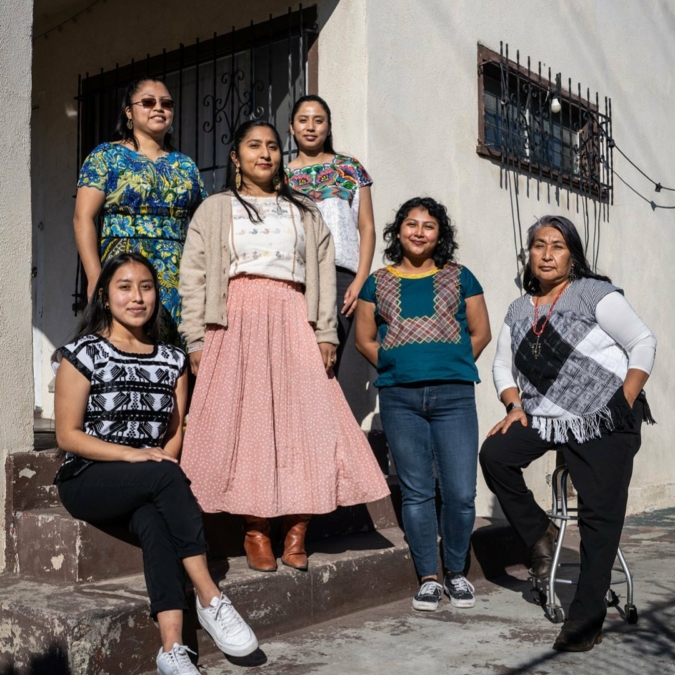UCLA LOSH Indigenous-language COVID-19 workplace safety videos aim to fill vital language gaps
The videos aim to reach Indigenous workers in industries that were highly-impacted by the pandemic
Citlalli Chávez-Nava | March 16, 2022
It is well-established that immigrant Indigenous workers play a critical role in the low-wage-service sector in Los Angeles.
Yet, amid the COVID-19 pandemic, statewide emergency workplace safety and health regulations that keep workers safe are often miscommunicated or lost in translation among these frontline workers.
Enter UCLA’s Labor and Occupational Health and Safety program (UCLA LOSH), a unit of the Institute for Research on Labor and Employment (IRLE), that partnered with the California Labor and Workforce Development Agency (LWDA) and Indigenous woman-led local non-profit organization Comunidades Indígenas en liderazgo (CIELO) to produce linguistically-appropriate COVID-19 informational workplace safety videos.
“In addition to developing educational materials in English and Spanish, we were hearing about the need to make materials available to Indigenous workers from Mexico and Central America – particularly in garment manufacturing, restaurants, warehouses, landscaping and construction,” said UCLA LOSH Director Kevin Riley.
Census data does not track Indigenous language speakers, but some estimates indicate that the L.A. region is home to between 120,000-220,000 Zapotec-speaking migrants from Oaxaca, Mexico.
Gaspar Rivera-Salgado, director at the UCLA Center for Mexican Studies and project director at the UCLA Labor Center, has studied Indigenous farmworkers for decades and explains that the need for multilingual worker safety information reflects a longstanding pattern of language invisibility.
“The system assumes that everybody south of the border speaks Spanish,” said Rivera-Salgado. “Indigenous languages are not recognized as official languages in California. They are what we call ‘exotic languages.’ So even state agencies, the court system or the educational system, do not have the information about the 68 Indigenous languages that are spoken in Mexico.”
To fill these gaps, organizations such as CIELO in Los Angeles assist Indigenous residents with translation in hospital, court, law enforcement and other public-serving settings.
Recently, CIELO partnered with other UCLA units to release an Indigenous diaspora mapping project, so working with LOSH built upon this university-community connection.
“The skills and trust that CIELO has built within the Indigenous language-speaking communities of Southern California made them a natural partner for our COVID-19 education efforts, so we connected with their staff and organizers as our project unfolded,” said Riley.
Together, the organizations identified the most commonly spoken Indigenous languages in the industries hit hardest by COVID-19: Maya K’iche (Nahuala Guatemala), Maya Mam (Western Highlands Guatemala and south-western Mexico), Maya Q’anjob’al (Huehuetenango, Guatemala), Mixteco (San Juan Mixtepec, Mexico) and Zapotec (Villa Hidalgo Yalalag, Mexico).
LOSH developed the content, including several messages around COVID-19 safety and workers’ rights in California, then wrote short scripts in English and Spanish. CIELO staff and partners then translated the scripts into each target Indigenous language and audio-recorded the translations.
The short clips – all under three minutes in length – pair the audio recordings and Indigenous-language text with animations and workplace iconography for easy distribution via social media. The videos present topics ranging from developing a COVID-19 Prevention Plan (CPP); assessing vaccination status; appropriate use of face coverings and respirators; to handling COVID-19 cases at the workplace. The video content reflects Cal/OSHA requirements established in June 2021 which will remain in effect at least through May 2022, although they may be extended through the end of the year.
The video project also represents the beginning of a deepened partnership between LOSH and CIELO to address other workplace safety hazards common in the industries and sectors that likely employ Indigenous workers in Southern California.
“Our next project will likely be focused on adapting educational messages around work-related heat illness prevention and protections from wildfire smoke, given the growing threats these hazards pose in light of climate change and the increased vulnerability that many of these workers face,” said Riley.
More broadly, there is hope that these collaborative efforts might lead to wider recognition of Indigenous languages and a professional, institutionalized approach to translation services for Indigenous workers and residents throughout the state.
“State agencies need to transform their organizations, to be up to the task of providing services to these diverse communities. Indigenous workers deserve these services,” added Rivera-Salgado.
All videos and additional information about this project can be found at: losh.ucla.edu/ets/.
In January 2022, CIELO in partnership with other UCLA units released a virtual mapping project that documents the Indigenous diaspora in Los Angeles. Based upon 2,500 household surveys, the map illustrates Indigenous language diversity and the prevalence of these workers in the Los Angeles service sector.


